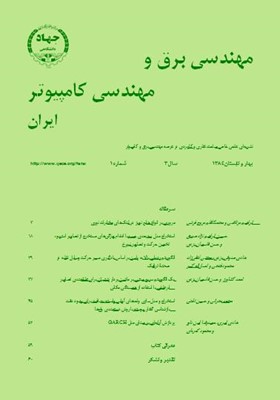يک الگوريتم سريع مبتني بر ماشين بردار پشتيبان براي طبقهبندي تصاوير ابرطيفي با استفاده از همبستگي مکاني
محورهای موضوعی : مهندسی برق و کامپیوترحسن قاسمیان یزدی 1 , احمد کشاورز 2
1 - دانشگاه تربیت مدرس
2 - دانشگاه تربیت مدرس
کلید واژه: تصاوير ابرطيفيسنجش از دورطبقهبنديطبقهبندي کننده سلسله مراتبيماشين بردار پشتيبان,
چکیده مقاله :
با افزايش تعداد باندهاي تصاوير سنجش از دور، الگوريتمهاي استخراج ويژگي مانند تحليل مؤلفههاي اصلي، تحليل مؤلفههاي مستقل، نگاشت جستجوگر، استخراج ويژگي با مرز تصميمگيري، تحليل مميز و تبديل موجک به منظور کاهش تعداد ويژگيها و بهبود طبقهبندي مورد استفاده قرار گرفتهاند. اما اين الگوريتمها به دليل افزايش تعداد منابع اطلاعاتي، حجم دادهها و محدود بودن تعداد نمونههاي آموزشي در تصاوير ابرطيفي، بازدهي مطلوبي ندارند. در اين مقاله براي حل اين مشکل، الگوريتم جديد مبتني بر ماشين بردار پشتيبان ارايه گرديده است. اين الگوريتم پس از يک طبقهبندي اوليه، با استفاده از کلاس هر پيکسل و همسايههايش به صورت سلسلهمراتبي تصميمگيري میکند. تصميمگيري در هر يک از سطوح اين طبقهبندي کننده بوسيله يک ماشين بردار پشتيبان انجام میشود. اين الگوريتم بر روي دادههاي واقعي ابر طيفي سنجنده AVIRIS اجرا شد. نتايج نشان ميدهد كه صحت طبقهبندي دادههاي ابرطيفي با استفاده از اين الگوريتم بسيار مطلوب بوده و مشكل محدود بودن تعداد نمونههاي آموزشي تا حد قابل توجهي جبران شده است. در واقع اين تحقيق با ادغام اطلاعات مکاني و استفاده از طبقهبندي کننده ماشين بردار پشتيبان صحت طبقهبندي را بهبود میبخشد. اين الگوريتم زمان لازم براي طبقهبندي تصاوير ابرطيفي را با استفاده از ماشين بردار پشتيبان، بسيار کاهش داده و کارآيي الگوريتم ماشين بردار پشتيبان را به عنوان طبقهبندي کننده تصاوير ابرطيفي افزايش میدهد.
Recent significant development in sensor technology makes possible Earth observational remote sensing system with unprecedented spectral resolution and data dimensionality. The value of these new sensor systems lies in their ability to acquire a nearly complete optical spectrum for each pixel in the scene. Such imaging spectrometry now makes possible the acquisition of data in hundreds of spectral bands simultaneously, and it is called hyperspectral images. With the limited number of training samples of hyperspectral images, the classification of these images using conventional feature extraction algorithms (PCA, ICA, PP, DBFE, DAFE and Wavelet) is considered useless. In this paper a two stages classification algorithm is proposed, by fussing the spatial and spectral information. In the first stage the classes of each pixel and its eight neighbors are identified, using a classical classification algorithm. In the second stage two primary classes of a pixel and its neighbors are compared in each node of decision tree by a SVM. The proposed, binary tree SVM, takes advantage of both the efficient computation of the tree architecture and the high classification accuracy of SVM. The hyperspectral data set used in our experiments is a scene from Indiana’s Indian Pine by the AVIRIS sensor. The examples results show the problem of limited training samples can be mitigated using the proposed algorithm; moreover the computational time is significantly reduced. This suggests that binary tree SVM could be a promising tool for classifying hyperspectral images.
[1] H. Ghassemian, A. Keshavarz, and D. Landgrebe, "Hyper-spectral image processing and analyses," Space Magazine, vol. 1, no. 3, pp. 32-41, Oct. 2003.
[2] G. F. Hughes, "On the Mean accuracy of statistical pattern recognizers," IEEE Trans. on Information Theory, vol. 14, no. 1, Jan. 1968.
[3] D. A. Landgrebe, "Hyperspectral image data analysis," IEEE Signal Processing Magazine, vol. 19, no. 1, pp. 17-28, Jan. 2002.
[4] H. Du, H. Qi, X. Wang, R. Ramanath, and W. E. Snyder, "Band selection using independent component analysis for hyperspectral image processing, " in Proc of AIPR workshop, pp. 93-98, 2003.
[5] L. Jimenez and D. A. Landgrebe, "Hyperspectral data analysis and feature reduction via projection pursuit," IEEE Trans. on Geoscience and Remote Sensing, vol. 37, no. 6, pp. 2653-2667, Nov. 1999.
[6] C. Lee and D. A. Landgrebe, "Feature extraction based On decision boundaries," IEEE Trans. on Pattern Analysis and Machine Intelligence, vol. 15, no. 4, pp. 388-400, Apr. 1993.
[7] S. Kaewpijit, J. L. Moigne, and T. E.Ghazawi, "Automatic wavelet spectral analysis for reduction of hyperspectral imagery," IEEE Trans. on Geoscience and Remote Sensing, vol. 41, no. 4, pp. 863-871, Apr. 2003.
[8] P. Mantero, G. Moser, S. B. Serpico, "Partially supervised classification of remote sensing images through SVM-based probability density estimation," IEEE Trans. on Geoscience and Remote Sensing, vol. 43, no. 3, pp. 559-570, Mar. 2005.
[9] A. Keshavarz and H. Ghassemian, "Hierarchical classification of hyperspectral images by using SVMs and same class neighborhood property," in Proc. of IEEE International Geoscience and Remote Sensing Symposium IGRSS2005, pp. 3219-3222, Jul. 2005.
[10] F. Melgani, L. Bruzzone, "Classification of hyperspectral remote sensing images with support vector machines," IEEE Trans. on Geoscience and Remote Sensing, vol. 42, no. 8, pp. 1778-1790,Aug. 2004.
[11] V. Vapnik and A. Chervonenkis,"The necessary and sufficient conditions for consistency in the empirical risk minimization method,'' Pattern Recognition and Image Analysis, vol. 1, no. 3, pp. 283-305, 1991.
[12] K. Goh, E. Chang, and K. T. Cheng, "SVM Binary classifier ensembles for image classification," ACM Int. Conf. on Information and Knowledgment Management (CIKM), pp. 395–402, Nov. 2001.
[13] H. Ghassemian and D. Landgrebe, "Object-Oriented feature extraction method for image data compaction," IEEE Control System Magazine, vol. 8, no. 3, pp. 42-46, Jun. 1988.
[14] http://dynamo.ecn.purdue.edu/~biehl/MultiSpec
[15] L. M. Bruce, C. H. Koger, and L. Jiang, "Dimensionality reduction of hyperspectral data using discrete wavelet transform feature extraction," IEEE Trans. on Geoscience and Remote Sensing,vol. 40, no. 10, pp. 2331-2338, Oct. 2002.


